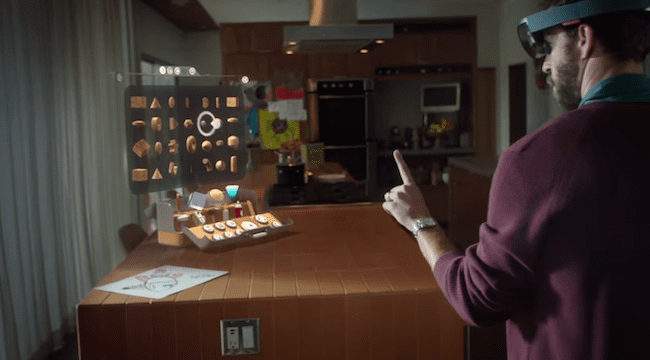There’s a new wearable in town. And it has the tech world abuzz because we really haven’t seen anything like it. Not in real-life anyway…
Let’s Just Admit It: Hololens is Incredibly Cool
Microsoft went public with its new connected headgear called Hololens last week. Hololens is essentially headset with glasses that augments ‘holograms’ — which can be things, dynamic interfaces, environments, etc.– that users can see, hear, and interact with in real-time. The interface? You eyes, for navigating; your hands for creating, shaping, selecting; your voice for communicating; your body for informing context. Digital content (we’re supposed to call them holograms) look as real as physical objects and features in the room. The Hololens maps its environment (e.g. your living room) and automatically blends selected holograms into the physical features, rendering the room the users’ canvas for holographic projects, applications, and games.
This is an Enterprise Play in (Sexy) Consumer Clothing
Microsoft’s snazzy promotional video foremost showcases the immense sexy factor (no doubt a tease for developers and investors), but it also illustrates quite compellingly a number of use cases for the device. Some of the use cases, like playing games, scrolling through Netflix are clearly consumer-facing (key for sparking buzz), but others are clearly business use cases.
- Collaboration: Wearing the headgear, an employee walks through the office while Skyping with co-workers, discussing status and shared files
- Design: An employee visualizes the product in development, pulls up a hologram to manipulate its dimensions and ideate with another in real-time
- Education: One person provides installation instructions to another, not only via video chat, but by being able to see what the installer can see– and draw instructions right on the screen
What else? Hololens could take enterprise mobile to another level. Consider the impact across business units: more efficiency in service, marketing, sales, innovation, operations, HR; indeed collaboration across all functions.
A Bold Move in a Crowded, but Surprisingly Quiet Ecosystem
The smart glasses space has been far less prolific than its other wearable neighbors (e.g. fitness trackers, smartwatches). And in the wake of Google Glass (R.I.P.), the B2C smart glasses space consists of virtual reality systems such as Facebook’s Oculus, and notification engines, like Recons. (There was buzz Samsung would release smart glasses before the end of last year, but so far it’s been only buzz.) Most others (CES darlings, for instance) have yet to move beyond pre-order. In the B2B space, the most advanced smart eyewear goes to Epson’s Moverio Smart Glasses (which boasts more patents than both Google and Apple).
In many ways, Microsoft’s Hololens dropping a bomb on an extremely green market– a market whose activations to date have left something to be desired. As Google licks its wounds from Glass’s demise– at least until it opens the kimono on MagicLeap, (the mysterious $542M augmented reality? acquisition); as Epson owns the B2B space, and as Apple stays characteristically tightlipped, the path for Hololens is crystal clear:
- Move swiftly: They’ve claimed the product will ship by the end of 2015. Competition is fierce.
- But make sure it works: The potential for friction in first generation tech is high– especially without the UI components we already know (e.g. mouse, keyboard, touchscreen); adoption relies on seamlessness, intuitiveness, value-creation, instant gratification.
- Bring sexy back: Capitalize on the enchantment (inspire developers and investors); bring sexy back for Microsoft; bring sexy back for wearables and mobile in general Enterprise adoption of Blackberry phones paved the way for mass adoption of smartphones; perhaps Hololens could do so for wearables?
As we peer through the [tinted] lens of how Hololens will fare, many factors remain unclear, namely cost, battery life, how ‘tethered’ the device will be to other components (e.g. power pack, laptop, etc.). We can’t help but stay sober to its elder, but clunky smart eyewear counterparts. Still, the ‘vision’ of augmenting our entire world has never seemed so close– we can almost touch it.
—
This post was originally published on Altimeter Group’s blog and can be found here.



